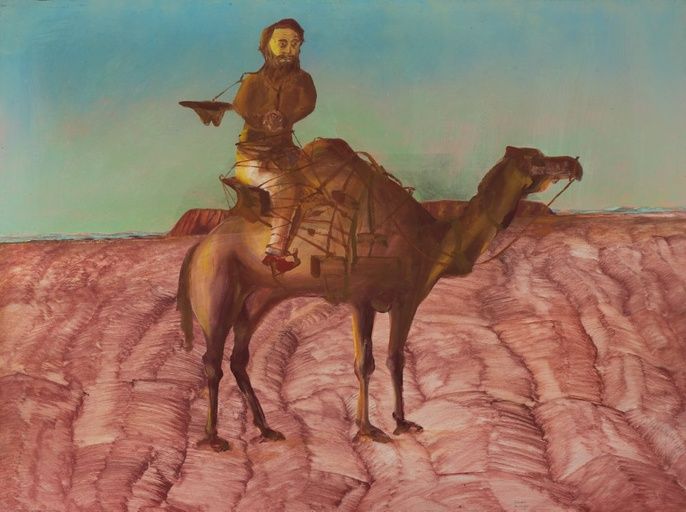

Burke and Wills’ Expedition ‘Gray Sick’, 1949
Sidney Nolan, Burke and Wills expedition, ‘Gray sick’, 1949, Ripolin enamel and oil-based red ochre on hardboard, 91.5 x 121.5 cm, Art Gallery of New South Wales. © Sidney Nolan Trust
Dr. Gary Sangster has international experience as an art educator, curator, writer, and museum director in Australia, New Zealand, Europe, and the USA. He was Curator at The New Museum of Contemporary Art in New York, and Director of the Contemporary Museum, Baltimore.
“Coming from Sydney’s western suburbs, a sprawling empire of parochial masculinity, a certain durable, resilient intellectualism committed me to understanding the cultural gulf between a cramped suburban vision of Australian colonialism and the internationalism inherent in Australia’s post-war view of modern art. From this vantage point, I never quite came to terms with a celebrated painter like Nolan, with his deftly economic mark-making, naively distorted figuration, and his quirky interrogation of narrative and environmental myths emerging starkly from the harshest zones of the Australian landscape. To me, Nolan frequently seemed like an icon of Australiana, sometimes forlorn, sometimes telling.
Like many of Australia’s greatest artists, the question at the heart of Nolan’s work is an inventive and occasionally poignant pursuit of both understanding and articulating Australian identity, what it means to be Australian and what makes Australian identity unique, valuable, or special. Nationalism is a constantly self-referential enterprise, that may explain or at least provide some insight into the profound effects of dislocation or the pronounced lean towards physical extremities in untamed lands.
The colonists’ rejection of indigenous culture as anything close to authentic, the immediate, outright, and ongoing denial of Aboriginal rights, meant that the settlers were up against it from the outset, attempting vainly to impose their will and their vision of genteel colonialism within a uniquely foreign nature. Searching constantly for their own strains of authenticity, it was not simply a struggle for survival in an unforgiving land, it was also a struggle to assert power and control against impossible odds of a fierce and fatal environment.
The prescience of Nolan’s project, where courage, heroism, masculinity, and folly are all encapsulated into the drama of Australia’s national creation myths, is to ensure the personal wreckage is lauded within the idealism of the pursuit. In this context, Nolan is a history painter, but an extraordinarily imaginative one, a painter of legends, a maker of legends, legends set in the barren wildness of the Australian plains and desert, amongst the scrubby farmland or in the wasteland mining sites. A documentarian of damned pursuits and failed enterprises.
In a remarkable painting of stark, moving presence, Burke and Wills’ Expedition ‘Gray Sick’, we see a doomed explorer perched upon an imperturbable camel which is stalled in a rutted, barren landscape. The figure, Burke or Wills, seemingly strapped to the continuously strange, non-indigenous species, presumably to prevent falling off his saddle, is set against an enormous, completely cloudless sky. The explorer and camel are both rendered in a monochrome kind of camel-like/sepia tone, the earth hatched in burnt crimson, and sky yellowing, like dusk, the beginning of the end of the day. This is a painful image of fallibility and failure, where the rider wears an expression of incomprehensibility towards inevitability. He has lost his hat, always a mistake in the desert, not thinking ahead, not reckoning on the tragic outcome of this misadventure.”